SEE WHAT IT WAS LIKE: MXA WRECKING CREW GOES KARTING
By John Basher
The average U.S. highway speed is 70 miles per hour. A 450 four-stroke can reach upwards of 65 mph on a motocross track. Aside from speed, these transportation devices have little in common. A father of four, toting his precious cargo inside a minivan bound for grandma’s house, is more worried about getting to his destination on time than beating the other drivers to the inside line on the next bend on Interstate 5. Yet in driving, as well as riding a dirt bike, the mind must properly judge distance and speed. This commonality is true in all sports—from NASCAR to baseball to curling. However, the senses are heightened when speeds are increased and distances are shortened. The mind must act as a super-processor by deciphering information and reacting with lightning-fast precision as the time-space continuum changes.
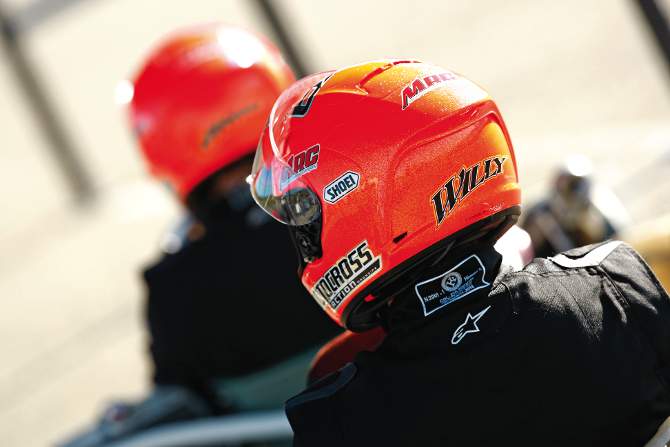
The orange MXA lid isn’t just for motocross.
Don’t believe me? Drive on the highway and maintain the speed limit. Then, drive on a curved road while maintaining the speed limit. If you’re a speed junkie, you’ll love the rush of adrenaline as the tires squeal and the car slides. For many, the thrill is worth the risk of careening off a mountainside. That’s why motorsports are so popular. NASCAR, Formula 1 and MotoGP are huge markets, with exorbitant television packages and millions of fans. The average person can relate to the car stars because they also drive a car. Granted, it’s a 180-degree difference from what Jimmy Johnson and Sebastian Vettel drive, but they feel the bond.
On a smaller scale, everyone who has ever ridden a Harley, Goldwing or Vespa thinks he is the next Valentino Rossi. It’s not hard to see that sports get their followers from those who have a personal connection to the activity. Every kid in America played baseball and football. Those are mainstream sports. Very few have ever jumped out of an airplane, thus the dearth of skydiving fans.
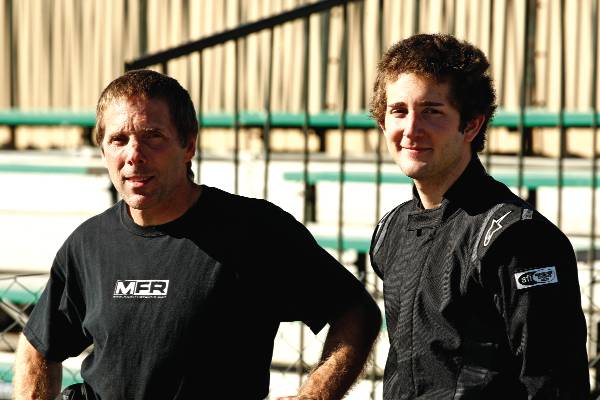
The Musgrave Racing father-son combo—Willy (on the left) and Billy.
Motocross riders are a small but passionate bunch. We thirst for the speed, danger, challenge and the competitive atmosphere that comes with riding a dirt bike. There is no substitute for motocross. Or is there? That’s exactly the question that MXA test rider Willy Musgrave asked himself eight years ago. A former AMA National Pro, after almost 40 years of racing motocross, Willy started to feel complacent. He’d done and seen it all, investing his life into a sport. Musgrave had won a round of the World Supercross Championships in India, worked as the production manager at a motorcycle company, built exhaust pipes for the White Brothers and DR.D, ran a major distributing company, and has been an MXA test rider for decades. Willy should have been pleased with his accomplishments.

As in motocross, getting a shifter kart properly set up takes time and money.
Do the same thing long enough and you might eventually grow tired of it. That’s obvious for an accountant, but not for a motocross rider. But Willy wanted to add more excitement to his life. So, Willy decided to buy a shifter kart and split his attention between dirt and asphalt. Don’t get us wrong, Willy was still racing and testing bikes, but his energies were divided. So was his bank account. Willy spent $9500 each on two new Arrow karts and convinced his son Billy, a 250 Pro, to try something new.
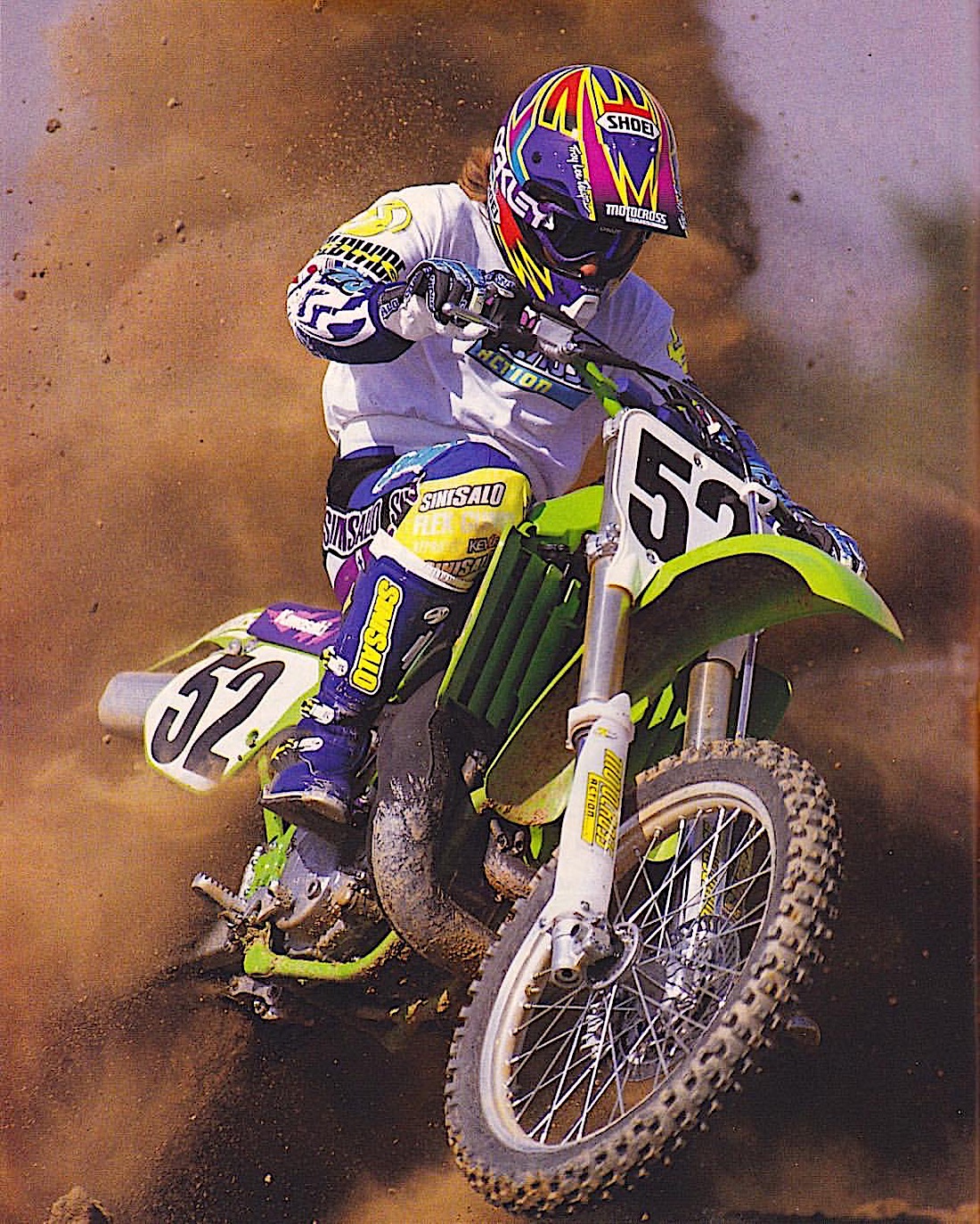 Willy Musgrave has been a long-time MXA test rider. Here he puts the 1994 Kawasaki KX500 through its paces.
Willy Musgrave has been a long-time MXA test rider. Here he puts the 1994 Kawasaki KX500 through its paces.
Most people associate go-karting with the rickety bumper cars that are prevalent at county fairs and children’s entertainment centers. That couldn’t be further from the truth. Karting, with shifter karts in particular, is intense. It requires cognitive, cerebral and physical competence to pilot a 200-plus-pound kart around a track—let alone race it with any success. Going over 80 miles per hour sitting 2 inches off the ground with only a plastic bumper protecting you from a concrete wall is insane. Covering 117 feet per second and entering a chicane with tires lining the track will make you think twice about overcooking the corner. Shifter karting isn’t for the faint of heart.
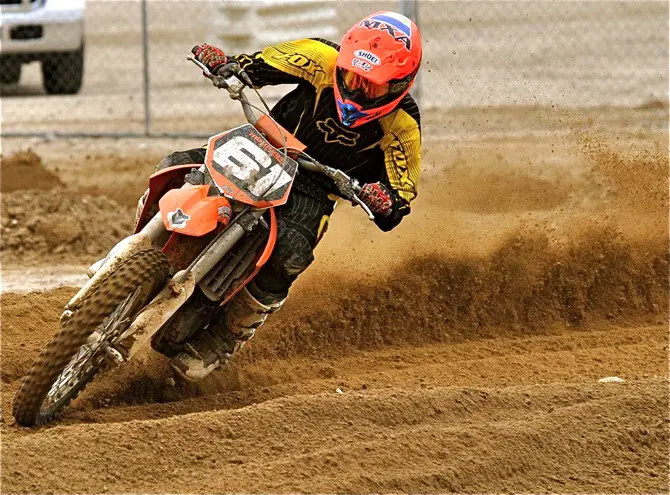
Billy Musgrave was a 250 Pro who never switched to four-strokes. He finished fourth in the 2012 World Two-Stroke Championships.
Willy Musgrave fell in love with the four-wheel sport almost immediately. He said, “After racing motocross for so long, I was looking for another competitive outlet. I was initially leery of shifter karts, because the upfront cost was expensive and I didn’t know if I would like it. Once I made the investment and drove a few times, I was blown away. There wasn’t any way that I could stop doing it.”
The MXA wrecking crew had reservations about Willy’s decision to pursue a new activity when he asked if he could start an MXA kart team made up of motocross racers. We wanted him at the motocross races with us and wondered what was so mystifying that he would skip the occasional motocross race to drive around in a parking lot. Willy said that we would understand if we went with him. So, we met the Musgraves at California Speedway to get a better understanding of shifter karting.
Old age and treachery don’t always overcome youth and skill. Willy’s son Billy is on the fast track to kart stardom; he has already arrived as a National Kart Championship.
Willy’s no slouch either. The older Musgrave has won his fair share of races in the Vet class (just as he has in motocross), and he’s also bringing his entrepreneurial skills into karting. Willy started Musgrave Racing Company (www.musgraveracing.com) out of his race shop in Corona, California. He sells complete racing karts and engines, as well as radiators, exhausts, cables, batteries and a host of other kart-specific products. Naturally sales skyrocketed after Billy won the Super Nationals on an MRC privateer kart.
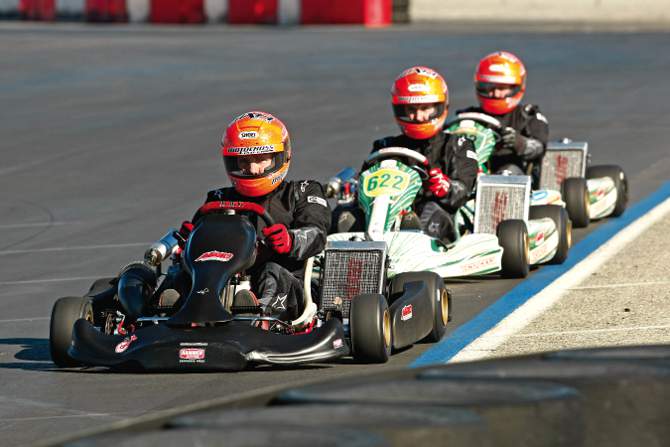
TACKLING THE LEARNING CURVE OF ASPHALT
Jody arranged with Willy for Daryl Ecklund and me to go to California Speedway to try our luck at shifter karting. Fortunately, since Willy has been an MXA test rider for 26 years, he took special joy in showing us the ins and outs of karting.
We quickly discovered that there are many similarities between motocross and shifter karting. Both use dirt bike engines—although in shifter karts, the power source of choice is almost totally two-stroke. They make four-stroke karts, but it isn’t the hot setup in the karting world. Both motocross and karting rely on shifting as well as using a clutch. What they don’t share is suspension. In motocross we spend long hours trying to get the forks and shocks dialed in, while a kart doesn’t have suspension. It depends on frame flex and a myriad of intricate setup tricks to fine-tune the performance of the vehicle. In fact, during the day of our test, Willy swapped out the rear-axle diameter in an effort to make the rear of the kart more rigid for better handling. It did the trick.

As with motocross, line selection and shifting points are also vital. Much to our surprise, the six-speed CR125 and the IAME 175cc engines were eye-watering fast. That engine might strain on a motocross track, but on asphalt, with incredible traction, the engine ripped. The meat of the powerband was from 8500 rpm to 12,500 rpm, and there was a lot of shifting to keep it there. We shifted, with a hand lever located next to the steering wheel, around 50 times on a 45-second course. Willy plugs up the power valve, because otherwise they would never shut.
We quickly discovered that fractions of a second make all the difference in the world. Unlike in motocross, where it’s possible to regain time from a blown corner by riding harder and deeper into the next corner, it’s hard to mask any mistakes when karting. Failing to properly set up for a corner will add time. Overcooking a turn will slow you down. Not keeping the engine running at the optimum rpm range will really hinder a lap time. Of course, Daryl and I did all of the aforementioned no-nos and several more.

A shifter kart retails for around $9500. It very well might be the best money that you’ve ever spent.
Musgrave admitted that there was a 50-percent success rate among first-time kart drivers. People either take to it like a fish to water, or they flounder on the asphalt. Luckily for Daryl and me, there is a positive correlation between motocross experience and achievement in karting. It makes sense, but Willy also mentioned that he has taught several top Pro riders (names withheld so as not to cause embarrassment) who were terrible behind the wheel. Our resident AMA National Pro Daryl Ecklund immediately grasped the concept of going fast in a shifter kart. He knocked off several 48-second lap times in his first driving session. Meanwhile, I struggled to find any modicum of comfort inside the kart. I dogged it in with a measly 54-second time.
Ever the teacher, Willy pulled us aside and offered advice. He recommended several better lines to Daryl and suggested that I shift out of the granny gear and wind out the engine. Billy Musgrave led us out for the second session. It was kind of like having Ryan Villopoto say, “Follow me.” Billy went slow enough for us to follow his swooping lines and zero in on his shifting points. The tactic worked, because Ecklund shaved two seconds off his time, and I knocked a full six seconds off my previous time. Eat your heart out, Michael Schumacher!

If you’re interested in learning how to drive a shifter kart, then Willy Musgrave is your man. He offers half- and full-day programs.
After logging 15 laps, we pulled into the pits, tired but excited at the prospect of further improving. I found it interesting that we were so fatigued, complaining about having a sore back and weak left forearm. In karting, most of the strain is put on the left arm, while the right hand takes care of shifting. The hand-operated clutch, located behind the left side of the steering wheel, is mostly used for starting and stopping.
In the third and final session we entered the track a bit cocky. Shaving time was going to be a breeze. I figured that we both could dip into the 44-second range and threaten young Billy Musgrave’s track record time of 43 seconds. How delusional we had become! I’ll admit that we were overzealous, lacking proper technique and forethought to keep the tires gripped and moving forward. The rudimentary approach might work in motocross, but not in karting. Consistent, mistake-free laps add up, but we were going backwards.
Frustrated, we pulled into the pits with half the rubber worn off the MG tires — which, at $200 for a set, are quite expensive — and gasped for air. Daryl asked, “How could I not improve? I was holding the gas on extra long, hitting the brakes late, and I kept the engine revving.” That’s when Willy Musgrave cracked a smile and said, “This isn’t motocross. Smoothness and precision are important. You both have the talent to do well at shifter-kart racing. Maybe with a few years of practice you could really do something.” We looked at one another with a puzzled look, flabbergasted by wily Willy’s response.
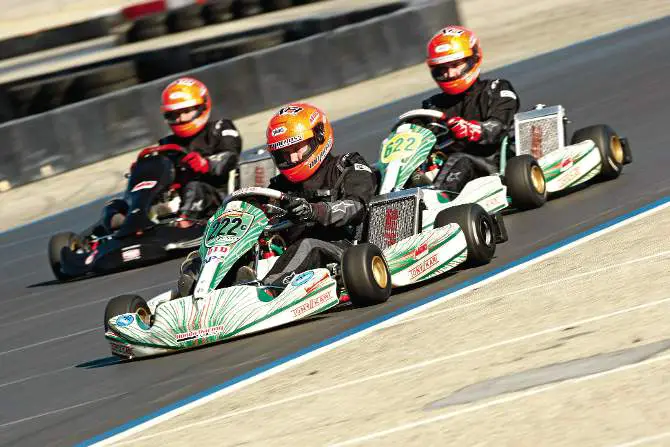
Behold three members of the MXA kart team. These six-speed, 125cc karts can go over 100 miles an hour.
Willy was right. Shifter karting certainly isn’t motocross. Even so, it’s relateable in so many ways. And, without a doubt, it’s a very addictive hobby. I understood why the Musgraves caught the shifter-karting bug. As the day wound down, Daryl and I pulled out of California Speedway and looked one last time at the track. Daryl said, “That was so much fun! I can’t wait to do it again. I bet that I could go even faster.”
I smiled, then noticed Billy Musgrave out on the track running hot laps. He took the hairpin so smooth that the kart seemed to be glued to the asphalt. I gasped and said to no one in particular, “So that’s how it’s done. I could totally do that!” Just then we laughed. It so happens that motocross riders share another trait—overconfidence.
 Billy Musgrave is a three-time kart Supernationals Champion.
Billy Musgrave is a three-time kart Supernationals Champion.
For more info go to:
Web: www.musgraveracing.com
Phone: (951) 314-4595
Address: 2970 Rubidoux Blvd.
Riverside, Ca 92509
HANG ON! A FEW LAPS WITH BILLY MUSGRAVE


![billy_phx[1]](https://cdn-0.motocrossactionmag.com/wp-content/uploads/2016/01/billy_phx1.jpg)


Comments are closed.